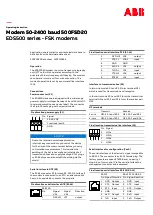
4
StarLink
™
SLe-GSM and SLe-GSM-3/4G Series GSM Communicators Installation Instructions
performance and ambient climate conditions. It is
HIGHLY recommended that the installer carefully ad-
here to the following recommendations BEFORE any
wires are installed.
•
Generally, high locations are best. DO NOT mount
radio in basements or below grade as unpredictable
performance may result.
•
Whenever possible, DO NOT mount the SLe-GSM
in non-climate controlled environments (i.e. attics
may become extremely hot in summer, garages
may become extremely cold in winter).
•
Avoid mounting locations within 3 feet of AC power
lines, fluorescent light fixtures, or large metal objects
(air conditioners, metal garage doors, etc.) as these
locations have been shown to have a detrimental
effect on signal strength.
•
A fair amount of care may be required to mount the
SLe-GSM so as to achieve an optimal RF path. The
installer should spend as much time as needed to
obtain the highest signal level possible.
a.
Before applying power, be sure to connect
the antenna
. Temporarily connect power to the
SLe-GSM from a fully charged 12V (4AH mini-
mum) battery. DO NOT mount the SLe-GSM at
this time.
b. Position the unit in the desired mounting location,
with antenna oriented vertically. The signal
strength is displayed by the Green "Signal
Strength LED" labeled "D3" (located at the lower
right corner of the PC board). GSM radio tower
signal strength may fluctuate from day to day,
therefore it is best to try to find a mounting loca-
tion where the LED provides a
minimum of 4
blinks
.
c. Once a location has been selected based on sig-
nal coverage, permanently secure the unit using
#8 screws (not supplied) in the two mounting
holes.
WARNING:
To ensure user safety and to satisfy
FCC RF exposure requirements, this unit must be
installed so that a minimum separation distance of
60cm (24") is always maintained between the an-
tenna of the transmitting device and nearby persons.
Use ONLY the existing antenna supplied by SLe-
GSM to comply with this warning.
STEP 3: WIRING (PRIMARY AND BACKUP MODES)
22-gauge wire may be used if mounted up to 50 feet
from the control panel, and 18-gauge wire should be
used for up to 100 feet. Reference the wiring diagrams
further in this manual.
Note:
If the control panel cen-
tral station receiver reporting format is "4/2 with check-
sum", be sure to install jumper #2 in jumper block la-
beled "X5". See the section
CONTROL PANEL PRO-
GRAMMING
further in this manual.
For Primary Mode:
Remove jumper #3 in jumper block labeled "X5". The
wiring between the control panel and the SLe-GSM is
over five (5) wires, as follows:
•
TB1: PWR (+12V)
•
TB2: PWR GND (–)
•
TB13: PANEL TIP
•
TB12: PANEL RING
•
TB3: PGM1 (–)
. Normally low output wired to the
(+) of a zone dedicated to monitoring the radio
status. Should be programmed on Napco control
panels as Day Zone, but be programmed to sound
locally and NOT activate the bell.
Note:
See steps
"a" and "b", below.
For Backup Mode:
Install jumper #3 in jumper block labeled "X5". The wir-
ing between the control panel and the SLe-GSM is over
seven (7) wires, as follows:
•
TB1: PWR (+12V)
•
TB2: PWR GND (–)
•
TB10: TIP
•
TB11: RING
•
TB13: PANEL TIP
•
TB12: PANEL RING
•
TB3: PGM1 (–)
. Normally low output wired to the
(+) of a zone dedicated to monitoring the radio
status. Should be programmed on Napco control
panels as Day Zone, but be programmed to sound
locally and NOT activate the bell.
a.
Without applying power (voltage)
, connect to
screw terminals
TB1 (+12V)
and
TB2 (–)
. If the
Aux. Output
cannot supply the necessary cur-
rent, then you must use the SLe-SMTCHG
Smart Charge Module accessory with additional
battery (see WI1946). For wiring connections,
see the wiring diagrams further in this manual.
b. Referencing the correct wiring diagram for the
appropriate control panel (wiring diagrams are
located further in this manual), connect the
"TELCO" control panel terminals TIP and RING.
Do NOT
connect the SLe-GSM terminals TB10-
13 to house telephone lines (RJ31X modular
plug wires, etc.).
STEP 4: APPLY POWER
•
The SLe-GSM requires 12VDC. It draws less than
65mA during standby,
and almost 400mA during
transmissions
(for less than 1 second).
•
Attach antenna before applying power !
STEP 5: SIGNAL VERIFICATION
After triggering channels, use the SLe-GSM Signal
Verification to insure that the SLe-GSM Network has
properly received the signals.
•
Verify Online
: To verify that the signals have been
received by the SLe-GSM Network online, go to
www.napconoc.com, log in with your Username and
Password, enter your
Company ID
number and the
SLe-GSM
Radio Number
, then click
Signal Log
.
IMPORTANT
: Verify that the signals transmitted by the
SLe-GSM have been properly received by your central
station.
NOTE:
This equipment has been tested and found to
comply with the limits for a Class B Unintentional Ra-


































